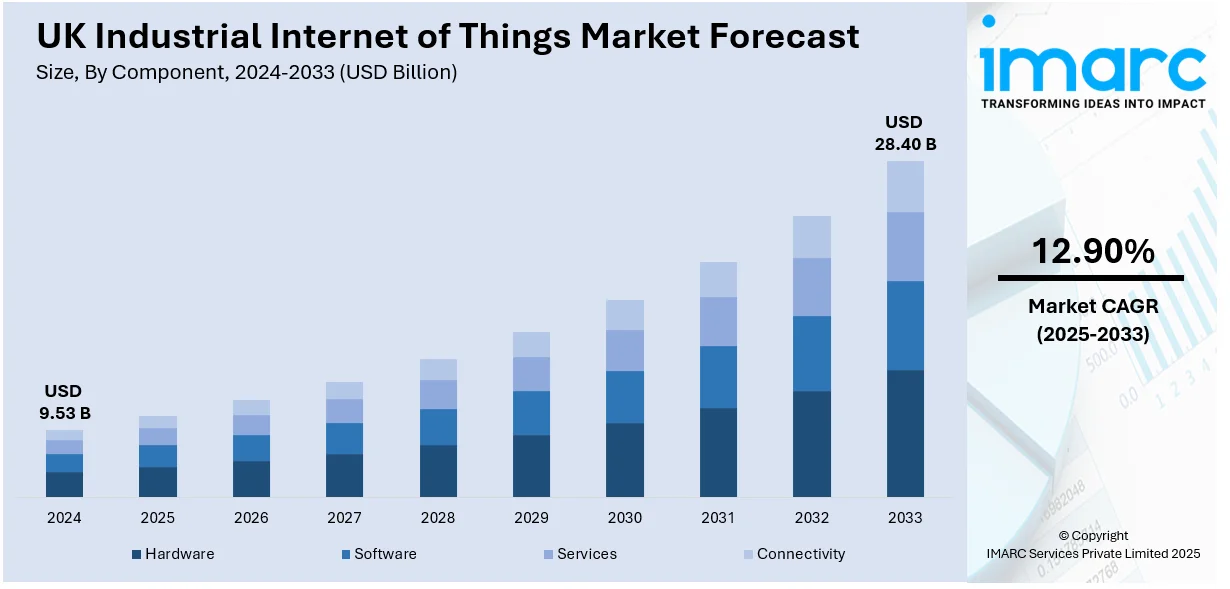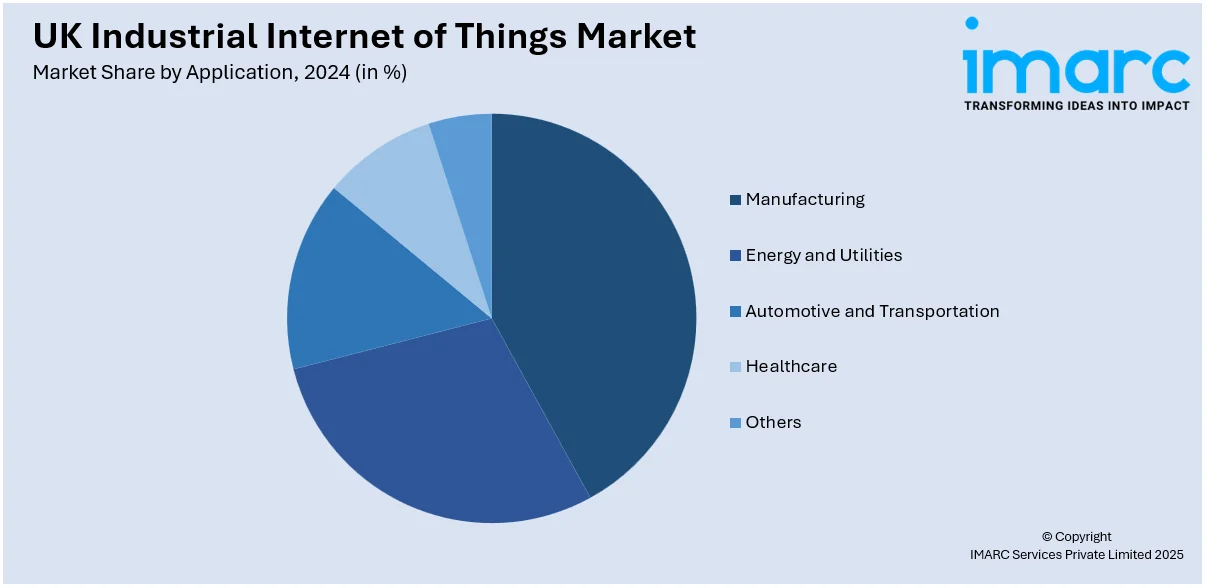
UK Industrial Internet of Things Market Size, Share, Trends and Forecast by Component, End User, and Region, 2025-2033
UK Industrial Internet of Things Market Overview:
The UK industrial internet of things market size reached USD 9.53 Billion in 2024. Looking forward, IMARC Group expects the market to reach USD 28.40 Billion by 2033, exhibiting a growth rate (CAGR) of 12.90% during 2025-2033. The rising automation, the increasing demand for operational efficiency, the increased adoption of AI and machine learning in production, the growing demand for predictive maintenance, the improved connectivity through 5G, the common adoption of smart factories, and government incentives for digital transformation of industries are some of the key drivers fueling the UK industrial internet of things market growth.
|
Report Attribute
|
Key Statistics
|
|---|---|
|
Base Year
|
2024
|
|
Forecast Years
|
2025-2033
|
|
Historical Years
|
2019-2024
|
| Market Size in 2024 | USD 9.53 Billion |
| Market Forecast in 2033 | USD 28.40 Billion |
| Market Growth Rate (2025-2033) | 12.90% |
UK Industrial Internet of Things Market Trends:
Significant Advancements in Connectivity
The deployment of 5G networks is greatly enhancing the capabilities of IIoT applications. The low latency, high speed, and higher bandwidth of 5G enable smooth communication among connected devices, making industrial operations more efficient. This enhanced connectivity is especially crucial for the adoption of smart factories and real-time monitoring in industries such as manufacturing, energy, and logistics, thus making it easier to adopt IIoT in the UK. For example, in July 2023, the government unveiled a £40 million fund designed to improve digital connectivity and spur the creation of next-generation wireless technologies. Towns and local communities across the country will be able to make their communities smarter and more connected, with the potential to develop anything from advanced farming to revolutionary healthcare solutions, all thanks to the IoT and 5G connectivity. The main objective is to create 5G Innovation Regions, where investment will be made available to regions with a high level of potential to promote the uptake and innovation of 5G and other revolutionizing technologies. Studies have revealed that the take-up of 5G on a mass scale could bring productivity gains of up to £159 billion by 2035, thereby further underscoring the need to invest in advanced wireless technologies.

Rising Government Initiatives and Digital Transformation
The UN says that digital technologies have a direct positive contribution to 70% of the SDG targets (119 out of 169), including critical goals like climate action, education, hunger, and poverty (UNDP, 2023). This has become more and more important, as the SDGs will most likely remain unachievable by 2030, or even 2050, without rapid development in current trends. Government assistance from the UK toward digital revolution in sectors and incentives for implementing new technologies is driving IIoT growth, particularly in industries such as manufacturing and energy. For example, in March 2024, the UK government press release announced a new UK digital development strategy which outlines how the UK will be at the front and collaborate with nations across the world, so nobody is left behind in the digital age. Digital technologies can facilitate development, for instance, mobile money and financial technology have made a significant contribution by bringing individuals across the globe into the digital economy. Similarly, artificial intelligence (AI) can potentially enhance health research and lower the cost of drug development. The UK's new approach, announced by Development Minister, aims to help countries make the most of the opportunities and least of the risks of an increasingly changing digital world. The approach is centered on 4 digital development priority areas such as last-mile connectivity, Digital Public Infrastructure (DPI), artificial intelligence, and women and girls.
UK Industrial Internet of Things Market Segmentation:
IMARC Group provides an analysis of the key trends in each segment of the market, along with forecasts at the regional level for 2025-2033. Our report has categorized the market based on component, end user and region.
Component Insights:
- Hardware
- Software
- Services
- Connectivity
The report has provided a detailed breakup and analysis of the market based on the component. This includes hardware, software, services, and connectivity.
End User Insights:

- Manufacturing
- Energy and Utilities
- Automotive and Transportation
- Healthcare
- Others
The report has provided a detailed breakup and analysis of the market based on the end user. This includes manufacturing, energy and utilities, automotive and transportation, healthcare, and others.
Regional Insights:
- London
- South East
- North West
- East of England
- South West
- Scotland
- West Midlands
- Yorkshire and The Humber
- East Midlands
- Others
The report has also provided a comprehensive analysis of all the major regional markets, which include London, South East, North West, East of England, South West, Scotland, West Midlands, Yorkshire and The Humber, East Midlands, and others.
Competitive Landscape:
The market research report has also provided a comprehensive analysis of the competitive landscape. Competitive analysis such as market structure, key player positioning, top winning strategies, competitive dashboard, and company evaluation quadrant has been covered in the report. Also, detailed profiles of all major companies have been provided.
UK Industrial Internet of Things Market News:
- In September 2025, firms such as Rolls-Royce, which is headquartered in London, are utilizing IIoT for the predictive upkeep of their jet engines. By integrating sensors into engines to track performance indicators like temperature, pressure, and vibration, Rolls-Royce is able to identify abnormalities and anticipate potential malfunctions before they happen.
- In April 2024, the United Kingdom became the initial nation to officially require cybersecurity standards for IoT devices. The newly enacted laws, effective as of today, are designed to protect consumers from cyber threats and enhance the country's strength against increasing cyber-crime. Under the Product Security and Telecommunications Infrastructure (PSTI) framework, it will be mandatory for manufacturers to incorporate security measures into any product that has internet connectivity.
UK Industrial Internet of Things Market Report Coverage:
| Report Features | Details |
|---|---|
| Base Year of the Analysis | 2024 |
| Historical Period | 2019-2024 |
| Forecast Period | 2025-2033 |
| Units | Billion USD |
| Scope of the Report | Exploration of Historical Trends and Market Outlook, Industry Catalysts and Challenges, Segment-Wise Historical and Future Market Assessment:
|
| Components Covered | Hardware, Software, Services, and Connectivity |
| End Users Covered | Manufacturing, Energy and Utilities, Automotive and Transportation, Healthcare, and Others |
| Regions Covered | London, South East, North West, East of England, South West, Scotland, West Midlands, Yorkshire and The Humber, East Midlands, Others |
| Customization Scope | 10% Free Customization |
| Post-Sale Analyst Support | 10-12 Weeks |
| Delivery Format | PDF and Excel through Email (We can also provide the editable version of the report in PPT/Word format on special request) |
Key Questions Answered in This Report:
- How has the UK industrial internet of things market performed so far and how will it perform in the coming years?
- What is the breakup of the UK industrial internet of things market on the basis of component?
- What is the breakup of the UK industrial internet of things market on the basis of end user?
- What is the breakup of the UK industrial internet of things market on the basis of region?
- What are the various stages in the value chain of the UK industrial internet of things market?
- What are the key driving factors and challenges in the UK industrial internet of things?
- What is the structure of the UK industrial internet of things market and who are the key players?
- What is the degree of competition in the UK industrial internet of things market?
Key Benefits for Stakeholders:
- IMARC’s industry report offers a comprehensive quantitative analysis of various market segments, historical and current market trends, market forecasts, and dynamics of the UK industrial internet of things market from 2019-2033.
- The research report provides the latest information on the market drivers, challenges, and opportunities in the UK industrial internet of things market.
- Porter's five forces analysis assist stakeholders in assessing the impact of new entrants, competitive rivalry, supplier power, buyer power, and the threat of substitution. It helps stakeholders to analyze the level of competition within the UK industrial internet of things industry and its attractiveness.
- Competitive landscape allows stakeholders to understand their competitive environment and provides an insight into the current positions of key players in the market.
Need more help?
- Speak to our experienced analysts for insights on the current market scenarios.
- Include additional segments and countries to customize the report as per your requirement.
- Gain an unparalleled competitive advantage in your domain by understanding how to utilize the report and positively impacting your operations and revenue.
- For further assistance, please connect with our analysts.
 Request Customization
Request Customization
 Speak to an Analyst
Speak to an Analyst
 Request Brochure
Request Brochure
 Inquire Before Buying
Inquire Before Buying




.webp)




.webp)












